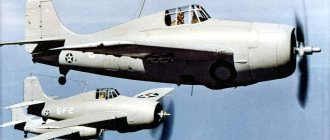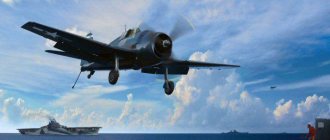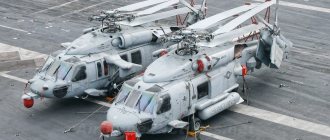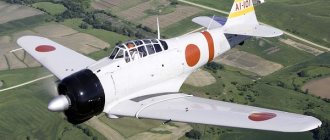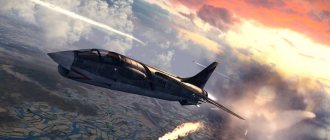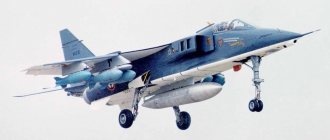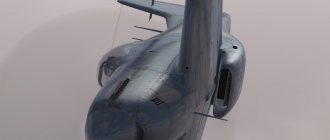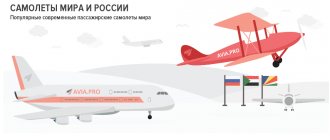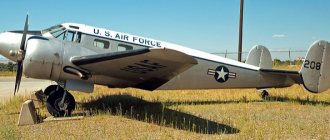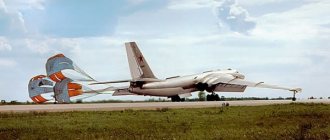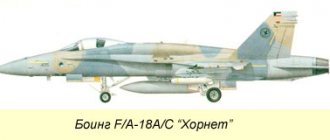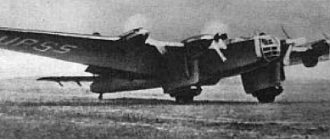Fighters
Grumman F-14 Tomcat. Interceptor fighter. (USA)
The Grumman F-14 Tomcat is an American third-generation two-seat jet fighter-interceptor with variable wing geometry, manufactured by Grumman Aircraft Engineering Corporation.
In 1965, the US Navy began developing tactical and technical requirements for a new fighter to gain air superiority. It was supposed to replace the outdated Phantom and be in service until the mid-90s.
In 1967, the work carried out was given the status of a program, and it was called VFX. Six companies, North American, Grumman, General Dynamics and LTV together with Lockheed presented their projects. Aircraft with a variable sweep wing (G303E) and McDonnell-Douglas with a fixed wing were selected as possible candidates. The winner was declared, which in 1969 received an order for the full-scale development of a fighter under the designation F-14 Tomcat.
Grumman F-14 Tomcat. Interceptor fighter. (USA)
Flight testing of the first prototype began on December 21, 1970, a month earlier than the deadline specified in the contract. A total of 12 prototypes were built. Test flights took place over Long Island; The F-14s “hung” in the air for 7-8 hours, refueling in flight from specially equipped Intruder attack aircraft.
From the very beginning, the F-14 Tomcat fighter was plagued by accidents and disasters. Thus, already on the second flight, the pilots were forced to eject due to a failure of the hydraulic control system. Tests were stopped and resumed only in May 1971. The following year, F-14 No. 10 crashed during demonstration flights in Pantaxent River (Maryland), and a year later, F-14 No. 3 crashed. The latter exploded in mid-air over the Point Mugu test site. A Sparrow missile launched from an F-14 Tomcat lost control and crashed into the lower part of the fuselage, ripping open the fuel tank. The crew managed to eject. The accident was explained by the presence of “easily removable vibrations,” and after appropriate modifications to the design, mass production of the aircraft began. The first combat squadrons (VF-1 and VF-2) were formed at the Miramar air base (California); they included vehicles starting with F-14 Tomcat No. 21. After training the flight and technical personnel, they were relocated to the aircraft carrier Enterprise (1974). Despite the company's statements about eliminating the shortcomings, accidents continued - in January 1975, the forty-third production aircraft exploded in the air at an altitude of 5000 m at a speed of 740 km/h; ten days later, another F-14A crashed (both belonged to the 2nd squadron). The next accident occurred on July 24, 1975—an engine fire. Later, two more planes crashed. Over ten years of operation, the fleet lost 64 vehicles. The overall combat readiness of units armed with F-14 Tomcat fighters was about 35%. The pilots noted that flying the F-14A is associated with great risk, especially at high altitudes and low speeds. The Navy command, in turn, was dissatisfied with the decrease in flight characteristics (compared to those specified in the order): maximum speed - by 6.2%, ceiling - by 5.2%, overload when turning - by 3.1%, flight duration - by 20%.
Grumman F-14 Tomcat. Interceptor fighter. (USA)
The main cause of F-14 Tomcat crashes and poor technical performance was the TF30 engine. Knowing this, even at the design stage, the company’s specialists developed another modification of the fighter—the F-14B (VFX-2) with F401 engines. But the new engine did not live up to the hopes placed on it, showing even lower performance during testing on car No. 7. As a result, an aircraft with obviously poor reliability began to be mass-produced.
Of course, one cannot fail to mention the advantages of the F-14 Tomcat, which it demonstrated during flight tests. The pilots managed to fly it steadily at a speed of 191 km/h and perform dizzying maneuvers when shown to the press: “The plane, moving vertically, gained altitude until the speed dropped to zero and the car began to move tail forward...” – wrote Aviation Week magazine 1973. The automatically variable wing sweep allows the fighter to sharply increase the angle of attack in horizontal flight (about 90″), braking the aircraft. This maneuver was called "Break" - "brake"
In early 1976, the prototype F-14 Tomcat No. 5 began testing as a strike aircraft under the designation A-14; This modification was not mass-produced. A similar fate befell another modification of the fighter - the F-14C. It was a variant of the F-14B with more advanced avionics.
At the request of the Navy, a reconnaissance modification RF-14A was developed to replace the RA-5C Vigelent reconnaissance aircraft (49 aircraft were produced). These aircraft are equipped with a container with the TARPS system (container length 5.27 m, diameter 0.67 m, weight 800 kg). The container is suspended under the fuselage; Inside there are two aerial cameras and an infrared reconnaissance station.
Serial production of the F-14 Tomcat fighter ended in 1987; In total, about 550 aircraft were produced. Three years before the end of production, she created an improved modification of the Tomket under the designation F-14A + (“Plas”). Instead of TF30 engines, it has more reliable and powerful F110 engines. The development was based on the engines of the B-1 aircraft. The first two new engines were tested back in 1981 on experimental fighter aircraft No. 7. But due to the lack of financial support at that time, the aircraft was mothballed. Now work has resumed; The first 38 Plas vehicles were delivered to the fleet in 1990. A little later, deliveries of the F-14D model began, which differs from the “Plas” in its avionics.
F-14A fighters were supplied to the Iranian Air Force (79 aircraft).
Being the main carrier-based fighter, the F-14 Tomcat was actively used in all local conflicts, although with varying degrees of success. In Lebanon, for example, three F-14s were shot down by anti-aircraft missiles. During the raid on Libya, F-14 Tomcats, on the contrary, shot down two MiG-23 fighters and two Su-17M (Su-22) fighter-bombers. In Iraq (1991), fighter jets had one helicopter shot down.
According to Navy representatives, by 2000, about 100 F-14s will be retired due to the exhaustion of their airframe life, and the question of replacing this type of aircraft will arise. Trying to extend the life of the machine, he is developing its new version, the Super Tomket-21, as well as the improved strike fighter ASP-14. The latter will have the avionics of an ATF aircraft. If there is no order for these machines, the company is ready to extend the service life of the F-14 airframes from 7,350 hours to 9,000 hours, which will keep them in service until 2012.
Grumman F-14 Tomcat. Interceptor fighter. (USA)
The F-14 Tomcat is a monoplane with a variable-sweep wing, the angle of which can smoothly change from 20° to 68° in flight and up to 75° when parked (to save space in the aircraft carrier hangar). The wing is equipped with slats, flaps and spoilers. In the fixed parts of the wing there are retractable triangular surfaces, which are designed to compensate for the diving moment when the wing sweep changes at supersonic speed. The fuselage of the aircraft consists of three parts: the nose (with the cockpit), the central part (with the wing rotation hinge) and the tail part (engines, air brakes, tail fairing). The tail unit is double-finned; the keels are installed with a camber of 5°. The aircraft stabilizer is all-moving, with differential deflection of surfaces. Air brake panels are located on the upper and lower surfaces of the tail fairing; their maximum deflection angle is 60°. When the landing gear is extended, the lower panel deflects only 18°, preventing it from hitting the deck during landing. The tail fairing of the aircraft was constantly modified: as it turned out, its shape greatly affects the overall aerodynamic drag. The aircraft has a three-post landing gear, borrowed from the A-6 Intruder attack aircraft. All racks are retracted forward and upward, the wheels of the main racks (when cleaning) rotate 90°. There are false fins under the engine nacelles to increase longitudinal stability at high angles of attack. The upper surface of the fixed parts of the wing is reinforced with four overlays in the form of aerodynamic ridges. On experimental machines they are much more massive than on production ones. On the starboard side of the forward fuselage there are two stepladders for the crew.
The first production samples were equipped with TF-30-P-412A engines, the subsequent ones were TF-30-P-414 with a steel “jacket” on the compressor. It covers the aircraft components when titanium blades are torn off, the edges of which are deliberately blunted. Engine length 5.99 m, diameter 1.29 m. Since 1988, the F-14A+ has been equipped with new F-110-GE-426 engines.
Adjustable bucket-type air intakes are installed at a distance of 250 mm from the fuselage surface. On the upper surface of each there is an adjustable slot, covered with a tiltable flap.
Six internal fuel tanks hold 9029 liters of fuel. Two additional fuel tanks of 1010 liters each can be suspended under the air intakes. There is a retractable boom with a fuel receiver for in-flight refueling.
The automatic control system of the aircraft provides for changing the wing sweep, extending additional surfaces, and maintaining the mode of direct control of the lift force (using spoilers). True, the overloads achieved by the aircraft in this mode are low: they allow the pilot to change the flight altitude without putting the aircraft into a dive or nose-down. To provide electrical power to on-board systems, there are two engine-driven alternators; The backup generator is driven by the hydraulic system.
The main combat system on board is considered to be the AWG-9 weapons control system. It consists of an on-board radar, a television or IR system (depending on the aircraft series) and a radio guidance link from a ground or air command post. The radar can detect targets at a range of 200 km and simultaneously track 24 of them from a distance of 185 km. Six targets (at a distance of 135 km) can be irradiated by the station in monopulse mode; this ensures the simultaneous guidance of six Phoenix guided missiles. A television or IR system is used to clarify the azimuth of the target and identify it. The aircraft's electronic warfare system can interfere with enemy radars (disrupting the "capture" mode) and communications. The antennas of this system are located at the tips of the keels.
The aircraft has a two-person crew: a pilot and a weapons system operator. The guides of the ejection seats of the crew are located with a slight inclination to the left (pilot) and to the right (operator), which eliminates collision during simultaneous ejection. In the operator's cabin there are indicators of the horizontal and vertical conditions. The F-14D cockpit features two multi-function displays in the cockpit and large-format digital displays in the navigator's cockpit.
Built-in weapons include a 20 mm Vulcan cannon with 675 rounds of ammunition. Suspended weapons can consist of various combinations of air-to-air missiles. Up to 4 Phoenix missile launchers are located under the fuselage on special beams. Instead, 4 Sparrow missiles or 4 AIM-120 missiles (in a semi-recessed position) can be suspended. Under the fixed part of the wing there are two suspended pylons that can accommodate: 2 Phoenix missiles or 2 AIM-120 missiles, 2 Sparrow missiles and up to 4 Sidewinder missiles. The fighter can also be used to attack ground targets. For this purpose, Mk.83 (up to 8 pcs.), Mk.84 (up to 4 pcs.) bombs are placed on special pylons (under the fuselage). Aiming during bombing is carried out using the navigation method due to the lack of special aiming systems. The total load weight reaches 6500 kg.
Options:
- The F-14A is the original two-seat multi-role fighter with the TF-30 turbofan engine.
- The F-14B is an advanced multi-role fighter aircraft with F110 engines and minor modifications to the design and cabin equipment.
- F-14D "Super Tomcat" - a variant of the F-110 turbofan engine and improved avionics.
- F-14С - variant with F401 turbofan engine and improved VREO.
- The F-14A++ is a modified version of the F-14A aircraft, which has been researched by the US Navy since 1992, using INS.
- F-14A/B+ - modified versions of the F-14A and F-14B aircraft proposed by Grumman in 1992.
The first production F-14 aircraft began entering service with the US Navy in October 1972. A total of 632 aircraft had been delivered to the US Navy by the time mass production ended in 1992.
Grumman F-14 Tomcat. Interceptor fighter. (USA)
Characteristics:
- Crew: 2 people (pilot and weapons operator);
- Length: 19.1 m;
- Wing span: folded - 11.65 m, deployed - 19.45 m, leading edge sweep in flight: 20° - 68°, parked 75°;
- Height: 4.88 m;
- Wing area: 54.5 m²;
- Wing profile: NACA 64A209.65 mod wing root, 64A208.91 mod wing tip;
- Empty weight: 18191 kg;
- Curb weight: 26632 kg;
- Maximum take-off weight: 33720 kg;
- Engine: 2× bypass turbojet with afterburner General Electric F110-GE-400;
- Maximum thrust: 61.4 kN;
- Afterburner thrust: 124.7 kN;
- Maximum speed: 2485 km/h (M=2.34) (at altitude);
- Combat radius: 926 km;
- Ferry range: 2960 km;
- Service ceiling: 16150 m;
- Rate of climb: 229 m/s;
- Wing load: 553.9 kg/m²;
- Thrust-to-weight ratio: 0.91;
- Cannon armament: 1 six-barreled M61A-1 Vulcan cannon, 20 mm caliber, 675 rounds;
- Combat load 5900 kg of various weapons: Air-to-air missiles: AIM-54 Phoenix, AIM-7 Sparrow, AIM-9 Sidewinder;
- Bomb armament: GBU-10, GBU-12, GBU-16, GBU-24, GBU-24E Paveway I/II/III LGB, GBU-31, GBU-38 JDAM, Mk-20 Rockeye II, Mk-82, Mk -83 and Mk-84;
- Weapon options: 2× AIM-9 + 6× AIM-54, 2× AIM-9 + 2× AIM-54 + 4× AIM-7, 2× AIM-9 + 4× AIM-54 + 2× AIM-7 , 2× AIM-9 + 6× AIM-7, 4× AIM-9 + 4× AIM-54, 4× AIM-9 + 4× AIM-7.
Carrier-based fighter Grumman F-14 Tomcat
In the second half of the sixties of the twentieth century, the command of the US Navy realized the need to replace the F-4 Phantom carrier-based fighter, which no longer provided air superiority. At the Mikoyan Design Bureau, work was in full swing to create the third generation fighter MiG-23. In 1965, the US Navy began formulating tactical and technical requirements for the new vehicle. In 1967, the program was named VFX.
Six American aircraft manufacturers, MaDonnel-Douglas, North American, General Dynamics and LTV together with Lockheed took part in the competition. Of the submitted projects, two were selected - and McDonnell-Douglas. The first (code G303E) featured a variable geometry wing. He was chosen for further work. Grumman began developing the F-14 Tomcat aircraft in 1969.
The first experimental Tomket took off on December 21, 1970. This was a month earlier than stated in the contract. The experimental series consisted of 12 aircraft. During testing, the fighters were in flight for 7-8 hours, using refueling. Modified A-6 “Intruders” were used as tankers.
There were some troubles. During the second flight, the hydraulics of the control system failed. The pilots left the car. This forced the tests to be suspended and returned to them only in May 1971. The following year, F-14 No. 10 crashed during demonstration flights in Pantaxent River (Maryland), and a year later, F-14 No. 3. The latter exploded in the air over the test site at Point Mugu. The Sparrow rocket launched from the Tomket lost control and crashed into the lower part of the fuselage, ripping open the fuel tank. The crew managed to eject. The accident was explained by the presence of “easily removable vibrations,” and after appropriate modifications to the design, mass production of the aircraft began. The first combat squadrons (VF-1 and VF-2) were formed at the Miramar air base (California); they included vehicles starting with F-14 No. 21. After training the flight and technical personnel, they were relocated to the aircraft carrier
Enterprise (1974). Despite the company's statements about eliminating the shortcomings, accidents continued - in January 1975, the forty-third production aircraft exploded in the air at an altitude of 5000 m at a speed of 740 km/h; ten days later, another F-14A crashed (both belonged to the 2nd squadron). The next accident occurred on July 24, 1975 - an engine fire. Later, two more planes crashed. Over ten years of operation, the fleet lost 64 vehicles. The overall combat readiness of units armed with Tomket fighters was about 35%. The pilots noted that flying the F-14A is associated with great risk, especially at high altitudes and low speeds. The Navy command, in turn, was dissatisfied with the decrease in flight characteristics (compared to those specified in the order): maximum speed - by 6.2%, ceiling - by 5.2%, overload when turning - by 3.1%, flight duration - by 20%.
The main cause of disasters and unsatisfactory technical performance was the TF30 engine. Knowing this, even at the design stage, specialists use interceptors). True, the overloads achieved by the aircraft in this mode are low: they allow the pilot to change the flight altitude without putting the aircraft into a dive or pitch-up. To provide electrical power to on-board systems, there are two engine-driven alternators; The backup generator is driven by the hydraulic system.
The main combat system on board is the AWG-9 weapons control system. It consists of an on-board radar, a television or infrared system (depending on the aircraft series) and a radio guidance link from a ground or air command post. The radar can detect targets at a range of 200 km and simultaneously track 24 of them from a distance of 185 km. Six targets (at a distance of 135 km) can be irradiated by the station in monopulse mode; this enables simultaneous guidance of six Phoenix guided missiles. A television or IR system is used to clarify the azimuth of the target and identify it. The aircraft's electronic warfare system can interfere with enemy radars (disrupting the "capture" mode) and communications. The antennas of this system are located at the tips of the keels.
The aircraft has a two-person crew: a pilot and a weapons system operator. The guides of the ejection seats of the crew are located with a slight inclination to the left (pilot) and to the right (operator), which eliminates collision during simultaneous ejection. In the operator's cabin
There are indicators of horizontal and vertical conditions. The F-14D cockpit is distinguished by the presence of two multi-function displays in the pilot's t&'ie and large-format digital indicators in the navigator's.
AIRPLANE WEAPONS
Built-in weapons include a 20 mm Vulcan cannon with 675 rounds of ammunition. Suspended weapons can consist of various combinations of air-to-air missiles. Up to 4 Phoenix missile launchers are located under the fuselage on special beams. Instead, 4 Sparrow missiles or 4 AIM-120 missiles can be suspended (in a semi-recessed position). Under the fixed part of the wing there are two suspended pylons that can accommodate: 2 Phoenix missiles or 2 AIM-120 missiles, 2 Sparrow missiles and up to 4 Sidewinder missiles. The fighter can also be used to attack ground targets. For this purpose, Mk.83 (up to 8 pcs.), Mk.84 (up to 4 pcs.) bombs are placed on special pylons (under the fuselage).
Aiming during bombing is carried out using the navigation method due to the lack of special aiming systems. The total load weight reaches 6500 kg.
Wingspan: sweep 20° 19.45 m sweep 68° 11.65 m Length. 18.9 m Height 4.88 m Wing area 52.5 m2 Empty weight, .. 18,100 ng normal take-off .. 26,780'ig (with 4 Sparrow missiles); Maximum .33 700 ig Flight speed 2550 km/h Service ceiling... 21 000 m Rate of climb at sea level 150 m/s Range 1230 nm Time to rise to altitude 18 000 m—170 s
F-14b, SYANBEPEMYARBNBUMMSHI BYUPKHYUMMR Tomcat, DN LYU 1991 TSNDYu ASHK KHGBEYAREM OND NANGMYUVEMHEL F-14A+. nM NRKHVYUKYA RPDDT General Electric F110-GE-400, YNRNPSHE HLEKH PJD BYUFMSHU OPEHLSYYARB ON YAYUBMEMHCH I HYAONKEGSELSHLH PUMEE DBHTSUREKLH TF30. xU BNGPNYAYU LNYNYARE ONGBNKKHKYU PEGYN SKSVIKHRE KERMSHE UYUPYUREPHYARKHYKH LYUKHMSH X BSHONKMYRE BGKER I YURYUOSKERSH MU ANEBNL PEFHLE PUANRSH YAHKNBNI SYARYUMNBYKH. RUYFE GMYUVHREKEMN YANYPYURKHKYA PUYAUND RNOKHBYU, YU ANEBNI PYUDKHSYA DEYARBHK SBEKHVKHKYA MU 62%. F110 ONGBNKKKH OKKNRS "GUASHRE" N DBKHTSYUREKU BN BPEL BNGDSMNTSN AN KH YABNANDMN DEIYARBNBURE psdYULKH, BME GYUBKHYAHLNYARKH NR STSKYU YURYUYKH YAYNPNYARKH.
dPSTSKHE NRKKHVKH F-14B BYKCHVYUKH KHGLEMEMKH B YNMYARPSYZHKH YPSHKYU, DNPUANRYUMMNE NANPSDNBYUMKHE YUAKHMSH, SYARYUMNBYS MNBNI YAKHYARELSH OPEDSOPEFDEMKH N PUDHNKNYUZHNMM NL NAKSVEMHH AN/ALR-67 I YUMREMMYULH OND YNPMEBNI VYUYARECH YPSHKYU, SYARYUMNBYS MNBNI YAHYARELSH Direct Lift Control/Approach Power Control X OEPEPUANRYS NRYAYU OSYKH, SYARYUMNBHB BLEYARN BEMRHKJHNMMSHU PEERNY GUANPMHYH NACA. RUYFE ASHKYU SYARYUMNBKEMYAHYARELYU DHYUTSMNYARKH DBKHTSYUREKEY H yb/sib PUDHNNANPSDNBYUMHE AN/ARC-182. lNDEPMKHGKHPNBUMMNI YAKHYARELE SOPIUBKEMKH NTsMEL AWG-9 ASHKN OPHYABNEMN MNBNE NANGMYUVEMHE AN/AWG-15F/H.
oYUPYUKKEKEMN I SHYYAOEPHLEMRYULH I DBKHTSYUREKEMSHLH SYARYUMNBYULH, YAOEZHHYUKHYARSH THPLSH Grumman ONYARNMMN BEKH PUANRSH MYUD LNDEPMHGYUZHHEI YUBKHNMHYH YAYULNKERYU. b PEGSKERYURE ONЪBHKYA BYUPHYUMR F-14C
I DBHTSUREKLH General Electric F101DFE, REKEBHGHNMMNI YAKHYARELNI PUYAONGMYUBYUMH JACKEY TCS, MYUBHTSYUZHNMMNI YAKHYARELNI Honeywell X ANKEE YANBEPEMMSHLH ANPRNBSHLH YNLOECHREPYULH. ndmuyn x shchryu bepyakh ME ASHKYU PEYUKHGNBYUMYU B YAEPHH. BOPNVEL, NOSHR, MYYNOKEMMSHI BN BPEL PUGPYUANRYKH KHYAOSHRYUMKHI BYAEU SHRKHU LNDKHTHYUZHKHI, ASHK HYAONKEGNBYUM OPH PUANRE MYUD LNDEKLKH F-14A+ X F-14D, YNRNPSHE ONGFE ON KH B YAEPHCH.
b OPNTsPYULLE YANGDUMHЪ F-14yu+ GYUDEYARBNBUKH EYARE YYULNKERNB, B RNL VHYAKE X YAYULNKER No. 157986, SFE ONYAKSFKHBKHI B 1973 TsNDS DK NRPYUANRYKH F-14b I DBKHTSUREKLKH Pratt & Whitney F401. oEPBSHI ONKER I DBHTSUREKLH F110-GE-400 SHCHRYU LYUHMYYANBEPEKHKYU 29 YAEMRP 1986 TsNDYU. ON ONKSVEMHH ONKNFHREKEMSHU PEGSKERYURNB HYAOSHRYUMKHI 15 TEBPYUK 1987 TSNDYU, "General Electric" ONKSVHKYU GYYUG YARNHLNYARECH 235 LKM DNAKYUPNB MU BSHOSYAY YAEPHIMSHU F110. fucking ONKSVHKH OEPBSHI YAEPHIMSHI DBKHTSYUREKE F110-GE-400 DKЪ F-14A+ 30 KhChM 1987 TsNDYu.
oEPBSHI XG OPNRNRKHONB F-14A+ No. 162910 BGKEREK B YAEMRYAPE 1986 TsNDYU. ONYARPNHKH 38 MNBSHU F-14A+, MN NMH ME LNTSKKH MEYARKH YNMREIMEP PUGBEDSHBUREKEMNI YAHYARELSH TARPS. UNR OEPBNMYUVYUKEMN OKYUMHPNBYUKNYAE, VRN BYAE F-14B ASDSR DNPYUANRYUMSH DN YARYUMDYUPRYU F-14D, B DUKEMEIEL NR SHCHRKHU OKYUMNB NRYUGYUKHYAE. BLEYARN SCHRNTSN F-14B ONKSVKHKH KHIE NRDEKEMSHE SCHKELEMRSH F-14D, BYKCHVYU YNMREIMEP I DYURVHYULH TCS/IRST OND MNYANBNI VYUYARECH.
b 1988 TsNDS fucking OPKHYARSOKHKH Y PEYUKHGYUZHHH OPNTsPYULLSH llayup (Multi-Mission Capability Avionics Program). nMY OPEDSYALYURPHBYUKYU SYARYUMNBYS SYANBEPEMYARBNBUMMNI YAHYARELSH OPEDSOPEFDEMH ON NAKSVEMHH AN/ALR-67, BEDYAYKHU YNMREIMEPNB I KNBSYYULH BOL MU OSAYNBSHU SYARPNIYARB YU PUYER Sidewinder, MNBNI ANPRNBNI schbl, DBSU ZHTPNBSHU HM NALEMYU HMTNPLYUZHHEI MIL-STD 1553b X MNBNTSN RUYRKHVEYAYNTSN DHYAOKE B YUAHME NOEPYURNPYU. oEPBSHE F-14A, DNPUANRYUMMSHE ON OPNTSPYULLE LLAYUP, ASHKH ONYARYUBKEMSH B 1994 TsNDS. ZhHTPNBSCH YAKHYARELS SOPYUBKEMKH ONKERNL GEC-Marconi YARYUKH SYARYUMYUBKHBYURE I 1996 TsNDYU, X ITS OPHLEMEMKHE GMYUVKHREKEMN SKSVIHKN SOPYUBKELNYARE Tomcat.
11 YUBTSSYARYU 1988 TsNDYu SHYAYUDPHKE VF-74 OEPBNI ONKSVKHKYU MNBSHE F-14A+. b 1989 TsNDS SHYAYUDPHKEH VF-103, VF-142, VF-143 X VF-211 YALEMHKH YABNH F-14A MU F-14A+. MN EYAKKH VF-142 ASHKYU PUYATNPLKHPNBUMYU B YUOPEKE 1995 TsNDYu, RN VF-103 ONLEMKYU YABNH Tomcat MU Super Hornet KHYE B YAEMRYAPE 2004 TsNDYu, a VF-143 X VF-211 - B 2005 TsNDS. b SHYAYYUDPHKECH VF-102 MU YUBKHYUAYUGE fucking nSYEMU OEPBSHE F-14B ONYARSOKHKH B KhChME 1994 TsNDYu, a VF-32 ONLEMKYU YABNH F-14A MU F-14B B YUBTSSYARE 1997 TsNDYu. ONYAKEDMKHI BSHKER YAYULNKERSH VF-32 YANBEPHKH B 2005 TsNDS, Y Y NYRAPCH SHYAYYUDPHKECH OEPEBNNPSFHKH MU F/A-18F Super Hornet, NROPYUBKHB Tomcat MU AYUGS UPYUMEMKH.
b 1998 TsNDS fucking yayu OPNBEKH OPNTSPYULLS SLEP DK OPNDKEMKH YAPNYU SHYYAOXYURYUZHKH, B UNDE YNRNPNI ASHKKH DNPYUANRYUMSH 67 F-14B, ONKSVKHBKHE MNBNE NANGMYUVEMHE F-14B Upgrade.
ONYAKEDMKHI F-14B ASHK YAMIR I BNNPSFEMKH B 2006 TsNDS. cru:
| lNDHTHYUZHH | F-14A+ |
| pYUGLUU YPSHKYU, L | |
| LYYYAHLYUKEMSHI | 19.55 |
| LHMHLYUKEMSHI | 11.65 |
| dKKHMYU YAYULNKERYU, L | 19.10 |
| bSHYANRYU YAYULNKERYU, L | 4.88 |
| OKNYYUDE YPSHKYU, L2 | 52.49 |
| I love it, JC | |
| OSYARNTSN YYULNKERYU | 18191 |
| LYUYAHLYUKEMYU BGKERMYU | 33800 |
| I love RNOXBY, JC | |
| BMSRPEMEEE | 7350 |
| ora | 1725 |
| RHO DBKHTSUREK | 2 RPDT General Electric F110-GE-400 |
| lyuyahlyukemyu rtsyu, ym | |
| TNPYAKHPNBYUMMYU | 2 U 120.10 |
| METNPYAHPNBYUMMYU | 2 U 71.20 |
| LYUYAKHLYUKEMYU YAYNPNYARE, YL/V | 1990 (l=1.88) |
| yPEIYEPYAYU YAYNPNYARE, YL,V | 765 |
| oEPETSNMNVMYU DUKEMNYARE, YL | 5210 |
| oPUYIRKHVEYAYKHI ONRNNKNY, L | 7,0 |
| lyuYa. SHYYAOXYURYUZHNMMMYU OEPETSPSGYU | 17000 |
| ShYKHOYUF, VEK | 2 |
| bNNPSPHEMHE: | BYARPNEMMYU 20-LL OSYU l61yu-1 (675 YAMYUPЪDNB) YAKEBYU ON ANPRS B MNYANBNI VYUYARKH TCHGEKKFYU. aNEBYU MYUTSPSGYU - 6580 YTS MU 8 SGKYU ONDBEYAYKH onD TCHGEKFEL LNTsSR PUGLEYYUREYA VERSHPE sp YAPEDMEI DUKEMNYARH AIM-7 Sparrow B ONKSONRNOKEMMNL ONKNFEMXX XKH sp ANKENNY DUKEM NYARKH AIM-54 Phoenix MU YAOEZHYUKEMSHU OKYURTNPLYUU. 4 sp AKHFMEI DUKEMNYARKH AIM-9 Sidewinder sua Rockeye, GBU-24/B, YYYAYAYERMSHE ANLASH RHOYU CBU |
| bottom. KhMTNPLYUZHKH: |
| tNRNCPYUTHH: | new F-14B (c) Grumman |
| F-14B (c) Glenn Beasley | |
| F-14B (c) Glenn Beasley | |
| F-14B (c) Gerard Helmer | |
| F-14B (c) Scott Rathbone | |
| F-14B (c) Ian Older | |
| F-14B (c) Ian Older | |
| oEPEDMYUAHMYU F-14B | |
| gYUDMYUAHMYU F-14B |
IWELSH:
| F-14B |
bYUPHYUMRSH NYPYYAYH:
| oPNRNRHO F-14B (c) Don Greer |
| F-14B |
| F-14B |
| YaOHYANY HYARNVMKHYNB: |
| Airforce Technology. F-14 Tomcat Standard Fleet Fighter Aircraft FAQs.org.Greg Goebel.Air Vectors. The Grumman F-14 Tomcat F-14A Tomcat F-14.org. F-14A Plus History and Specifications Squadron/Signal. Al Adcock. F-14 Tomcat in Action Airlife. Bert Kinzey. F-14A&B in Detail & Scale |
sTSNKNY MEAYU. 2011
